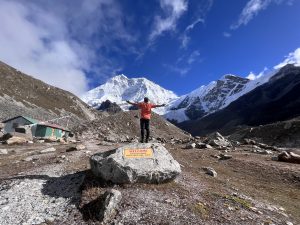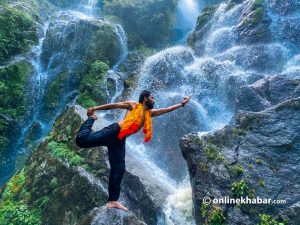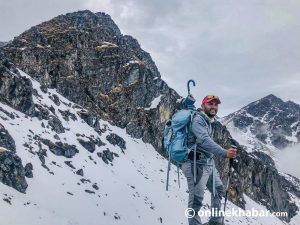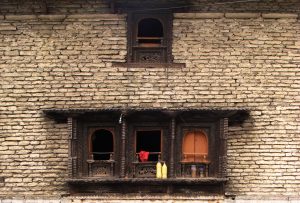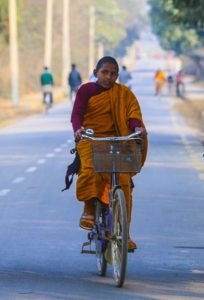Of all the sounds of Nature that have been lost in Kathmandu, the one of flowing water is the one sorely missed.
The city’s rivers are portraits of tragedy. Some of us might remember the days when the rivers of Kathmandu could be heard. Others have been to places where water flows freely or rages on or plunges spectacularly. But there is a growing segment of the city’s populace that might never have had the pleasure of seeing swift flowing rivers or roaring waterfalls.
Fortunately, that aspect of Nature’s music and motion awaits them within the Valley.
Waterfalls are an enthralling show of water’s expression of its freedom. “There is enchantment in flowing water: I [am] hypnotised by its beauty,” the novelist and poet Vikram Seth once wrote, moved by the sight of several waterfalls near a village on the Nepal-Tibet border.
Kathmanduites are lucky to have two such sites of enchantment within the Valley. One is at Sundarijal. It comes into view at the end of one of the first taxing climbs up from the village. The location is perfect. Your calves are aching, back drenched in sweat, the sun beating down relentlessly when a sudden coolness kisses your face—the mist from the waterfall. The roar comes next, followed by the first sight of the waterfall.
It’s a milky torrent, cascading down a rock face smothered by vines. The refreshing spray entices you to go closer; the deafening roar makes you hesitate. Sundarijal, Beautiful Water, seems an apt name for a place where water flaunts its beauty.

Shyalmati Jharna, as the locals call it, is a border of sorts. If you walk past it, you enter the wilderness that is the Shivapuri National Park. Visitors, presumably ones in their teens, have given it another name: Sweet Sixteen Waterfall. Getting a light coat of mist, you can sit and watch the Bagmati spurt forth from between massive boulders. Coming from the city where bodies of water have long been defeated and shackled into stagnation, this sight of water running wild and free is a welcome sight.

The other waterfall within the Valley is a gift of the monsoons. A small plume of water in the dry season, the waterfall near the Baundeshwor Mahadev shrine turns into a majestic pillar of white water in the rainy season. Getting there, too, is a passage through one of the monsoon season’s most refreshing sights: green seas of rice fields.
Baundeshwor, or Jhor Mahankal as it is also known, is located north of the ancient Newar town of Tokha. It’s a lovely drive on a paved road (potholed in places) through a verdant countryside. The waterfall tumbles down from a forested hill. Beside it is a small shrine dedicated to Lord Shiva. Hundreds of people visit the shrine on Saturdays and Mondays. But people also go there simply to be in the refreshing vicinity of the waterfall. In the monsoon there are mini waterfalls all around the Baundeshwor waterfall, offering personal discoveries for those willing to risk slimy trails and leeches.
A trip to any of these waterfalls is a chance to be in the midst of all that has been banished from our city—greenery, tranquility, fields and forests. And the almost-forgotten verses of the poem that is a waterfall, that “sounding cataract falling whitely into chaos, that informs the purity of a uniform element with the varying impulse of life.”
Checklist
Baundeshwor, or Jhor Mahankal as it is also known, is located north of the ancient Newar town of Tokha.
Getting There

Shyalmati
Buses depart throughout the day from the Old Bus Park in Kathmandu for Sundarijal. The route is through Putalisadak, Gyaneshwor, Gaushala, Chabahil, Jorpati. Sundarijal is approximately 18km from the Old Bus Park.
Baundeshwor
There is a bus every 15 minutes (or so the bus company claims, but buses tend to wait longer if there are only a handful of passengers onboard) from Samakhusi Chok to Baundeshwor Chok. The fare is 35 rupees. If you plan on going and coming back on a public bus you must remember that the last bus down from Baundeshwor departs at 5:30 PM. Miss that bus and your only option will be hitchhiking.
To get to Baundeshwor you need to get to where the Tokha Road splits from the Ring Road. This junction is a little ways east of Samakhusi Chok. The landmark is a big Grande Hospital hoarding board. Head straight (north) on the Tokha Road. After 4 km you will arrive at Tokha, an old town sitting atop a knoll. Keep going north on the main road. The road forks at the northern end of Tokha; there, take the left, downhill road toward Jhor. Another 4 km on this road will get you to Baundeshwor Chok. If you’re on a private vehicle, keep going north for another 1.3 km to get to the parking spot. Since monsoon is the time to visit Baundeshwor , it’s best to walk up to the waterfall and shrine from the Baundeshwor Chok. It’s riskier coming down to the shrine from the parking spot, as the trail is slimy and steep.
Safety First

Where there are waterfalls there is slippery ground. In the monsoons, this risk is increased by the appearance of moss and algae. It’s hard to resist getting close to waterfalls, but you need to be careful. Boulder-hopping in Sundarijal might seem like a good idea, but it’s best to enjoy the scene from a distance. The access to the waterfall at Baundeshwor is a narrow trail, most of which is taken up by people queuing up to do puja at the shrine. Do not try to take alternate routes that involve climbing up on wet rocks to get close to the waterfall. Inform the volunteers that you are there only for the waterfall and they will let you through.
What to eat

The eateries in Sundarijal offer everything from dal bhaat to tidbits. There are fewer eateries in the vicinity of Baundeshwor, although there are occasional places selling snacks and some simple lodges calling themselves resorts on the way. Tokha has the most places to eat on the way to Baundeshwor.
Side Trips

Sundarijal is not only about leaping water. The first thing after climbing up from the Sundarijal market is a hydropower station, the second-oldest in Nepal. An intense climb from the Shyalmati waterfall will bring you to the Sundarijal Museum. The museum commemorates the life of B.P. Koirala, who was imprisoned in the same building during the Panchayat period. If you have time and wish to extend your stay in the tranquil environs, you can continue uphill to the Tamang village of Mulkharka.
If you are into traditional Newar architecture and localities, stop in Tokha en route to Baundeshwor. There are plenty of narrow alleys here to loiter in and make mini discoveries, one of which might be arriving at a shop making the town’s famous chaku (molasses). Turn right from the northern end of Tokha for Chandeshwori, an old shrine at the edge of a forest. Hidden in the forest some fifty meters from the Baundeshwor waterfall is another, smaller waterfall. Ask the volunteers at the Baundeshwor Mahadev shrine for directions.
***
Also read






